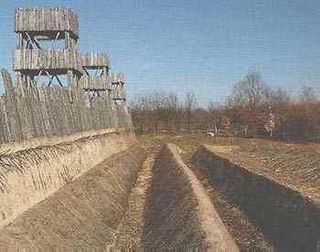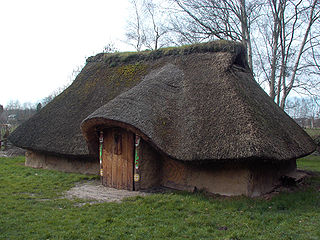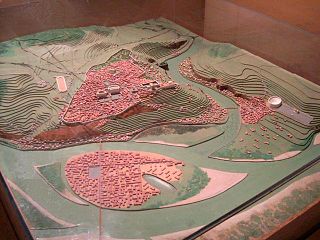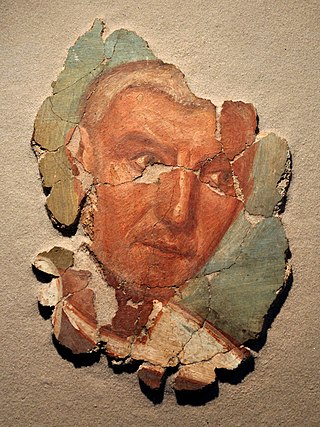| History of France |
|---|
 |
| Topics |
| Timeline |
Roman Gaul refers to Gaul [note 1] under provincial rule in the Roman Empire from the 1st century BC to the 5th century AD.
| History of France |
|---|
 |
| Topics |
| Timeline |
Roman Gaul refers to Gaul [note 1] under provincial rule in the Roman Empire from the 1st century BC to the 5th century AD.




The Roman Republic's influence began in southern Gaul. By the mid-2nd century BC, Rome was trading heavily with the Greek colony of Massilia (modern Marseille) and entered into an alliance with them, by which it agreed to protect the town from local Gauls, including the nearby Aquitani and from sea-borne Carthaginians and other rivals, in exchange for land that it wanted in order to build a road to Hispania, to assist in troop movements to its provinces there. The Mediterranean settlements on the coast continued to be threatened by the powerful Gallic tribes to the north and in 122 BC the Roman general Gnaeus Domitius Ahenobarbus campaigned in the area and defeated the Allobroges followed by Quintus Fabius Maximus against the Arverni under King Bituitus in 121 BC. [1]
The Romans respected and feared the Gallic tribes. In 390 BC, the Gauls had sacked Rome, which left an existential dread of barbarian conquest the Romans never forgot. [2] In 109 BC, Italy had been invaded from the north and saved by Gaius Marius only after several bloody and costly battles. Around 62 BC, when a Roman client state, the Arverni, conspired with the Sequani and the Suebi nations east of the Rhine to attack the Aedui, a strong Roman ally, Rome turned a blind eye. The Sequani and the Arverni sought Ariovistus's aid and defeated the Aedui in 63 BC at the Battle of Magetobriga. [3] [4]
As 58 BC dawned, most of Gaul was still under independent rule. It was beginning to urbanize and shared many aspects of Roman civilization. Into this picture came the rising general Julius Caesar, who had ensured himself the position of Governor of both Transalpine and Cisalpine Gaul. He sought to pay off debts and find glory for himself, and so began a series of aggressive campaigns to conquer the Gallic tribes. [5]
The wars began with conflict over the migration of the Helvetii in 58 BC, which drew in neighboring tribes and the Germanic Suebi. By 57 BC, Caesar had resolved to conquer all of Gaul, and led campaigns in the east, where the Nervii nearly defeated him. In 56 BC, Caesar defeated the Veneti in a naval battle and took most of northwest Gaul. In 55 BC, he sought to boost his public image, and undertook first of their kind expeditions across the Rhine river and the English Channel. Upon his return from Britain, Caesar was hailed as a hero, though he had achieved little beyond landing because his army had been too small. The next year, he went back with a proper army and invaded Britain. However, tribes rose up on the continent, and the Romans suffered a humiliating defeat. 53 BC saw a draconian campaign against the Gauls in an attempt to pacify them. This failed and the Gauls staged a mass revolt under the leadership of Vercingetorix in 52 BC. Gallic forces won a notable victory at the Battle of Gergovia, but the Romans' indomitable siege works at the Battle of Alesia utterly defeated the Gallic coalition. [5]
In 51 BC and 50 BC, there was little resistance and Caesar's troops were mostly mopping up. Gaul was conquered, although it would not become a Roman province until 27 BC, and resistance would continue until as late as 70 AD. There is no clear end-date for the war, but the imminent Roman Civil War led to the withdrawal of Caesar's troops in 50 BC. Caesar's wild successes in the war had made him extremely wealthy and provided a legendary reputation. The Gallic Wars were a key factor in Caesar's ability to win the Civil War and declare himself dictator, in what would eventually lead to the end of the Roman Republic and the establishment of the Roman Empire. [5]
At the end of the Gallic Wars, the Gauls had not been entirely subjugated and were not yet a formal part of the Empire, but that task was not Caesar's and he left that to his successors. Gaul would not be made formally into Roman provinces until the reign of Augustus in 27 BC. Several rebellions happened subsequently and Roman troops were kept stationed throughout Gaul. There may have been unrest in the region as late as 70 AD. [6]
Massilia was allied to Pompey in Caesar's civil war, which led to its eventual defeat at the Siege of Massilia in 49 BC after which it lost its territories but was allowed to keep nominal autonomy, due to ancient ties of friendship and support of Rome.
In 40 BC, during the Second Triumvirate, Lepidus was given responsibility for Gallia Narbonensis (along with Hispania and Africa), while Mark Antony was given the balance of Gaul. [7]
In 22 BC, imperial administration of Gaul was reorganised establishing the provinces of Gallia Aquitania, Gallia Belgica and Gallia Lugdunensis. Parts of eastern Gaul were incorporated into the provinces Raetia (15 BC) and Germania Superior (AD 83).
Roman citizenship was granted to all in 212 by the Constitutio Antoniniana.
Several significant Roman figures were born in Gaul, including Roman Emperors Claudius, Caracalla and probably Carus, as well as the important general Gnaeus Julius Agricola. Another general born in Gaul was Marcus Antonius Primus. In addition, the family of Antoninus Pius, which was also the adoptive family of Marcus Aurelius, came from Roman Gaul. Roman writers born in Gaul include Petronius, Caecilius Statius, Varro Atacinus, Aemilius Magnus Arborius, Frontinus, Ausonius, Rutilius Claudius Namatianus, Gnaeus Pompeius Trogus and the authors of the important Panegyrici latini. It's unclear if Tacitus and Cornelius Gallus were born in provincial Gaul or in Cisalpine Gaul, which was part of Italy (many other writers were from the latter region, including Virgil, Catullus and Pliny).
In the Crisis of the Third Century around 260, Postumus established a short-lived Gallic Empire, which included the Iberian Peninsula and Britannia, in addition to Gaul itself. Germanic tribes, the Franks and the Alamanni, invaded Gaul at this time. The Gallic Empire ended with Emperor Aurelian's victory at Châlons in 274.
In 286–7 Carausius, commander of the Classis Britannica, the fleet of the English Channel, declared himself Emperor of Britain and northern Gaul. [8] His forces comprised his fleet, the three legions stationed in Britain and also a legion he had seized in Gaul, a number of foreign auxiliary units, a levy of Gaulish merchant ships, and barbarian mercenaries attracted by the prospect of booty. [9] In 293 emperor Constantius Chlorus isolated Carausius by besieging the port of Gesoriacum (Boulogne-sur-Mer) and invaded Batavia in the Rhine delta, held by his Frankish allies, and reclaimed Gaul.
A migration of Celts from Britain appeared in the 4th century in Armorica led by the legendary king Conan Meriadoc.[ citation needed ] They spoke the now extinct British language, which evolved into the Breton, Cornish, and Welsh languages.[ citation needed ]
The Goths, who had sacked Rome in 410, established a capital in Toulouse and in 418 succeeded in being accepted by Honorius as foederati and rulers of the Aquitanian province in exchange for their support against the Vandals. [10]
The Roman Empire had difficulty responding to all the barbarian raids, and Flavius Aëtius had to use these tribes against each other in order to maintain some Roman control. He first used the Huns against the Burgundians, and these mercenaries destroyed Worms, killed king Gunther, and pushed the Burgundians westward. The Burgundians were resettled by Aëtius near Lugdunum in 443. The Huns, united by Attila, became a greater threat, and Aëtius used the Visigoths against the Huns. The conflict climaxed in 451 at the Battle of Châlons, in which the Romans and Goths defeated Attila.
The Western Roman administration finally collapsed as remaining Roman troops withdrew southeast to protect Italy. Between 455 and 476, the Visigoths, the Burgundians, and the Franks assumed control in Gaul. However, certain aspects of the ancient Celtic culture continued after the fall of Roman administration and the Domain of Soissons, a remnant of the Empire, survived from 457 to 486.
In 486, the Franks defeated the last Roman authority in Gaul at the Battle of Soissons. Almost immediately afterwards, most of Gaul came under the rule of the Merovingians, the first kings of a proto-France.
In 507, the Visigoths were pushed out of most of Gaul by the Frankish king Clovis I at the Battle of Vouillé. [11] They were able to retain Narbonensis and Provence after the timely arrival of an Ostrogoth detachment sent by Theodoric the Great.
Certain Gallo-Roman aristocratic families continued to exert power in episcopal cities (such as the Mauronitus family in Marseilles and Bishop Gregory of Tours). The appearance of Germanic given and family names becomes noticeable in Gallia/Francia from the middle of the 7th century on, most notably in powerful families, indicating that the centre of gravity had definitely shifted.
The Gallo-Roman (or Vulgar Latin) dialect of the late Roman period evolved into the dialects of the Oïl languages and Old French in the north, and into Occitan in the south.
The name Gallia and its equivalents continued in use, at least in writing, until the end of the Merovingian period in the 750s. Slowly, during the ensuing Carolingian period (751–987), the expression Francia , then Francia occidentalis spread to describe the political reality of the kingdom of the Franks (regnum francorum).

Before 22 BC, Gaul had three geographical divisions, one of which was divided into multiple Roman provinces:
After 22 BC, the Romans divided Gallia Comata into three provinces, the Tres Galliae (the 3 Gauls):
The Romans divided these huge provinces into civitates corresponding more or less with the pre-Conquest communities or polities sometimes described misleadingly as "tribes," such as the Aedui, Allobroges, Bellovaci, and Sequani (see List of Celtic tribes) but the civitates were too large and in turn were divided into smaller units, pagi, a term that eventually became the modern French word "pays". [12] These administrative groupings would be taken over by the Romans in their system of local control, and these civitates would also be the basis of France's eventual division into ecclesiastical bishoprics and dioceses, which would remain in place—with slight changes—until the French Revolution.


In the five centuries between Caesar's invasion and the collapse of the Western Roman Empire, the Gaulish language and cultural identity underwent a syncretism with the Roman culture of the new governing class, and evolved into a hybrid Gallo-Roman culture that eventually permeated all levels of society.[ citation needed ] Gauls continued writing some inscriptions in the Gaulish language, but switched from the Greek alphabet to the Latin alphabet during the Roman period. Current historical research suggests that Roman Gaul was "Roman" only in certain (albeit major) social contexts, the prominence of which in material culture has hindered a better historical understanding of the permanence of many Celtic elements.[ citation needed ] The Roman influence was most apparent in the areas of civic religion and administration. The Druidic religion was suppressed by Emperor Claudius I, and in later centuries Christianity was introduced. The prohibition of Druids and the syncretic nature of the Roman religion led to disappearance of the Celtic religion. It remains to this day poorly understood: current knowledge of the Celtic religion is based on archaeology and via literary sources from several isolated areas such as Ireland and Wales.
The Romans easily imposed their administrative, economic, artistic (especially in terms of monumental art and architecture) and literary culture.[ citation needed ] They wore the Roman tunic instead of their traditional clothing.[ citation needed ] Surviving Celtic influences also infiltrated back into the Roman Imperial culture in the 3rd century. For example, the Gaulish tunic—which gave Emperor Caracalla his surname—had not been replaced by Roman fashion. Similarly, certain Gaulish artisan techniques, such as the barrel (more durable than the Roman amphora) and chain mail were adopted by the Romans.
The Celtic heritage also continued in the spoken language (see History of French). Gaulish spelling and pronunciation of Latin are apparent in several 5th century poets and transcribers of popular farces. [14] The last pockets of Gaulish speakers appear to have lingered until the 6th or 7th century.[ citation needed ] Gaulish was held to be attested by a quote from Gregory of Tours written in the second half of the 6th century, [15] which describes how a shrine "called 'Vasso Galatae' in the Gallic tongue" was destroyed and burnt to the ground. [16] Throughout the Roman rule over Gaul, although considerable Romanization in terms of material culture occurred, the Gaulish language is held to have survived and continued to be spoken, coexisting with Latin. [15]
Germanic placenames were first attested in border areas settled by Germanic colonizers (with Roman approval). In the 4th and 5th centuries, the Franks settled in northern France and Belgium, the Alemanni in Alsace and Switzerland, and the Burgundians in Savoie.
Villas were usually centres of agricultural production, and were often closely associated with vineries and wine production. [17] The owners were probably mainly local Gallic elites who became quickly romanised after the conquest, and sometimes Romans and Italians who wished to exploit rich local resources. [18] The villas would have been the centre of complex relationships with the local area. Much of the work would have been undertaken by slave labour or by local coloni ("tenant farmers"). There would also have been a farm manager in addition to the inhabiting family. [19]
The Aedui or Haedui were a Gallic tribe dwelling in what is now the region of Burgundy during the Iron Age and the Roman period.

Vercingetorix was a Gallic king and chieftain of the Arverni tribe who united the Gauls in a failed revolt against Roman forces during the last phase of Julius Caesar's Gallic Wars. After surrendering to Caesar and spending almost six years in prison, he was executed in Rome.

Gaul was a region of Western Europe first clearly described by the Romans, encompassing present-day France, Belgium, Luxembourg, and parts of Switzerland, the Netherlands, Germany, and Northern Italy. It covered an area of 494,000 km2 (191,000 sq mi). According to Julius Caesar, who took control of the region on behalf of the Roman Republic, Gaul was divided into three parts: Gallia Celtica, Belgica, and Aquitania.

Commentarii de Bello Gallico, also Bellum Gallicum, is Julius Caesar's firsthand account of the Gallic Wars, written as a third-person narrative. In it Caesar describes the battles and intrigues that took place in the nine years he spent fighting the Celtic and Germanic peoples in Gaul that opposed Roman conquest.

Gallia Aquitania, also known as Aquitaine or Aquitaine Gaul, was a province of the Roman Empire. It lies in present-day southwest France, where it gives its name to the modern region of Aquitaine. It was bordered by the provinces of Gallia Lugdunensis, Gallia Narbonensis, and Hispania Tarraconensis.

The Arverni were a Gallic people dwelling in the modern Auvergne region during the Iron Age and the Roman period. They were one of the most powerful tribes of ancient Gaul, contesting primacy over the region with the neighbouring Aedui.

The Battle of Alesia or siege of Alesia was the climactic military engagement of the Gallic Wars, fought around the Gallic oppidum of Alesia in modern France, a major centre of the Mandubii tribe. It was fought by the Roman army of Julius Caesar against a confederation of Gallic tribes united under the leadership of Vercingetorix of the Arverni. It was the last major engagement between Gauls and Romans, and is considered one of Caesar's greatest military achievements and a classic example of siege warfare and investment; the Roman army built dual lines of fortifications—an inner wall to keep the besieged Gauls in, and an outer wall to keep the Gallic relief force out. The Battle of Alesia marked the end of Gallic independence in the modern day territory of France and Belgium.

Gallia Narbonensis was a Roman province located in what is now Occitania and Provence, in Southern France. It was also known as Provincia Nostra, because it was the first Roman province north of the Alps, and as Gallia Transalpina, distinguishing it from Cisalpine Gaul in Northern Italy. It became a Roman province in the late 2nd century BC. Gallia Narbonensis was bordered by the Pyrenees Mountains on the west, the Cévennes to the north, the Alps on the east, and the Gulf of Lion on the south; the province included the majority of the Rhone catchment. The western region of Gallia Narbonensis was known as Septimania. The province was a valuable part of the Roman Empire, owing to the Greek colony and later Roman Civitas of Massalia, its location between the Spanish provinces and Rome, and its financial output.

Gallia Belgica was a province of the Roman Empire located in the north-eastern part of Roman Gaul, in what is today primarily northern France, Belgium, and Luxembourg, along with parts of the Netherlands and Germany.

The Menapii were a Belgic tribe dwelling near the North Sea, around present-day Cassel, during the Iron Age and the Roman period.

The Lingones were a Gallic tribe of the Iron Age and Roman periods. They dwelled in the region surrounding the present-day city of Langres, between the provinces of Gallia Lugdunensis and Gallia Belgica.

Lugdunum was an important Roman city in Gaul, established on the current site of Lyon. The Roman city was founded in 43 BC by Lucius Munatius Plancus, but continued an existing Gallic settlement with a likely population of several thousands. It served as the capital of the Roman province of Gallia Lugdunensis and was an important city in the western half of the Roman Empire for centuries. Two emperors, Claudius and Caracalla, were born in Lugdunum. In the period 69–192 AD, the city's population may have numbered 50,000 to 100,000, and possibly up to 200,000 inhabitants.

Ariovistus was a leader of the Suebi and other allied Germanic peoples in the second quarter of the 1st century BC. He and his followers took part in a war in Gaul, assisting the Arverni and Sequani in defeating their rivals, the Aedui. They then settled in large numbers into conquered Gallic territory, in the Alsace region. They were defeated, however, in the Battle of Vosges and driven back over the Rhine in 58 BC by Julius Caesar.

The Suessiones were a Belgic tribe, dwelling in the modern Aisne and Oise regions during the La Tène and Roman periods.

The Sequani were a Gallic tribe dwelling in the upper river basin of the Arar river (Saône), the valley of the Doubs and the Jura Mountains during the Iron Age and the Roman period.

Gallo-Roman culture was a consequence of the Romanization of Gauls under the rule of the Roman Empire. It was characterized by the Gaulish adoption or adaptation of Roman culture, language, morals and way of life in a uniquely Gaulish context. The well-studied meld of cultures in Gaul gives historians a model against which to compare and contrast parallel developments of Romanization in other less-studied Roman provinces.

The Gauls were a group of Celtic peoples of mainland Europe in the Iron Age and the Roman period. Their homeland was known as Gaul (Gallia). They spoke Gaulish, a continental Celtic language.
The Helvii were a relatively small Celtic polity west of the Rhône river on the northern border of Gallia Narbonensis. Their territory was roughly equivalent to the Vivarais, in the modern French department of Ardèche. Alba Helviorum was their capital, possibly the Alba Augusta mentioned by Ptolemy, and usually identified with modern-day Alba-la-Romaine. In the 5th century the capital seems to have been moved to Viviers.

The Sanctuary of the Three Gauls(Tres Galliae) (French: Sanctuaire fédéral des Trois Gaules) was the focal structure within an administrative and religious complex established by Rome in the very late 1st century BC at Lugdunum (the site of modern Lyon in France). Its institution served to federalise and develop Gallia Comata as an Imperial province under Augustus, following the Gallic Wars of his predecessor Julius Caesar. The distinctively Gallo-Roman development of the Imperial sanctuary and its surrounding complex are well attested by literary, epigraphic, numismatic and archaeological evidence.
Le déclin du Gaulois et sa disparition ne s'expliquent pas seulement par des pratiques culturelles spécifiques: Lorsque les Romains conduits par César envahirent la Gaule, au 1er siecle avant J.-C., celle-ci romanisa de manière progressive et profonde. Pendant près de 500 ans, la fameuse période gallo-romaine, le gaulois et le latin parlé coexistèrent; au VIe siècle encore; le temoignage de Grégoire de Tours atteste la survivance de la langue gauloise.